Well that seems to have been a shorter week than usual. Maybe it is the fact that the nights are slowly closing in. They certainly are, at least in these parts. And it is dark, too, when morning supposedly comes.
I am not too fond of darkness, though armed with my chromebook I find I can read on it quite well, and can also enlarge the print simply by sliding my fingers along the keypad. Or I can watch television, though nothing too flashy light wise - Gardener`s World is always a nice gentle start to my day.
I have also just started to discover the delights of the podcast, though I am some months behind with "the one that made me find out how to make them work".
The one thing that seems a little lacking are podcasts on cards, and I have not found many YouTube films, though I know there are almost certainly others yet to find. So if anyone knows any especially good ones - or even makes them - do please let us know.
I look forward to hearing from you, at webmaster@card-world.co.uk - and this is also the address to contact with updates and corrections to the newsletter and anything else on our site.
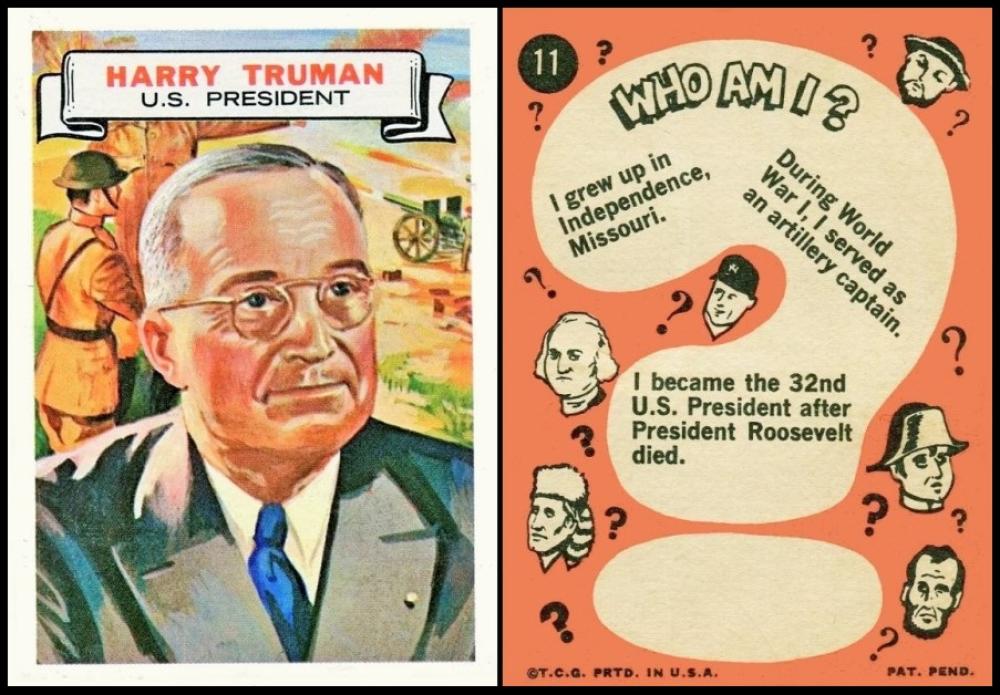
Topps Chewing Gum [trade : bubble gum : O/S - USA] "Who Am I?" (1967) 11/44
Today, in 1947, saw the first ever live, televised, Presidential Address from the White House, by our featured man, President Truman. Now some may say this was the start of a very slippery slope indeed, but we will pass swiftly on.
There will be readers who cannot imagine a time when they could not see things like this every day, but at that time there were no mobile phones, no computers as we know them today spilling forth an abundance of news on all manner of topics, from the great to the truly awful.
Those readers may also find it hard to believe that the main topic of the conversation was the food shortage in Europe - for though the Second World War was supposed to have ended in 1945, there was still mass deprivation, and people scattered all about, some of whom would never return for all manner of reasons. There had also, cruelly, been flooding, cold, heat, and drought, some of which may indeed have been caused by the things that were done to win the war, the rise in nuclear armament, the great amount of munitions of all kinds on every side exploding forth their unnatural cargoes up into the air.
However the President also spoke of plans to help Greece and Turkey, who were more or less at war, and some of their neighbours, who either had been, or ran the risk of being, dragged in.
Most Americans never saw the broadcast, for they did not have television yet. With this in mind, the speech was also released to movie theatres, where they hoped it would reach a wider audience.
This card is allied in many ways to other Topps sets, but the true collector would not be very interested in our main card above, for this is not the way it was pulled from the packet, and originally President Truman would have been disguised. So if anyone has one of these untouched cards, do let us know - and then we can also show you how the card looked when it first saw the light of day in a collector`s hand.
You can read more about the set at TraderCracks/WHO and there is a handy checklist. This reveals that there are four baseball cards included in the set, so if you want a complete set you will have to dig deep into that wallet, especially as one of them is Babe Ruth (card number 12).
We do know that the packets with these cards in cost five cents each, but not how many cards were included. Also it clearly states bubble gum, which is always pleasing to be able to record.
The packets also contain instructions for removing the disguise, namely : "Scratch off with coin or fingernail". This needed to be done very slowly and gently though, and, sadly, too many youthful, unpractised fingers, scratching way too heavily, ended up damaging cards, either by rubbing the disguise into the card and leaving unsightly and irremovable marks, or by scratching white lines in the very front layer where the image was.
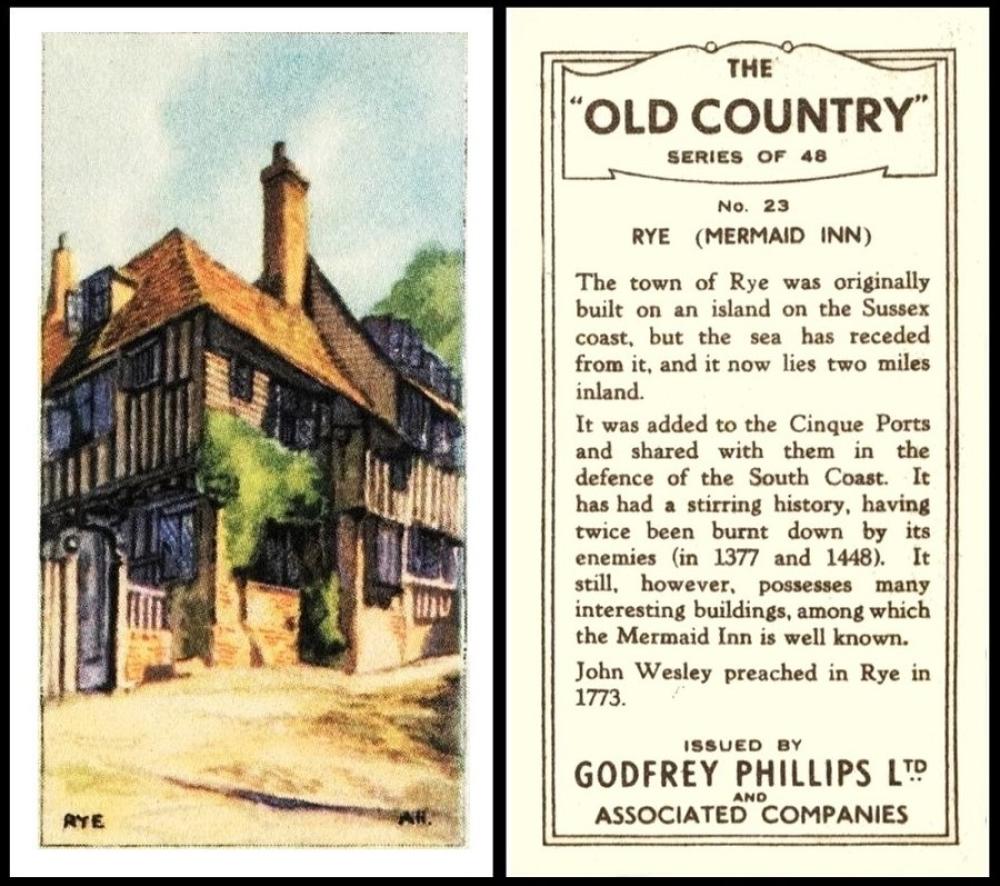
Godfrey Phillips [tobacco : UK] "The Old Country" (1935) 23/48 - P521-458 : P50-115 : Ph/105 [RB.13/105]
Today, its Sunday, so don`t just leap out of bed. Lie a while. This is especially true if you are taking advantage of today`s #CountryInnBedBreakfastDay. And yes, it really is a day, the first Sunday in October.
Country Inn Bed and Breakfast Day was first celebrated in 2005. It seems to have come about because this time of year, people start not wanting to go out too much, as the summer dwindles, so the inns, and many of the small country towns, start to empty of their visitors. So events like this do serve to fill the gap, until Hallowe`en, and then until everyone is out and about to celebrate Christmas.
I have chosen to explore the Mermaid Inn at Rye. It is not strictly very countryside, but it has an interesting tale, naming each of its rooms after a colourful local character, and retaining its olde worlde Tudor charm despite being regularly updated. There are thirty one rooms, with panelling and stone fireplaces, from which you can gaze and dream through romantic latticed windows. There are also twelfth century cellars, ghosts, and a secret smugglers staircase, well hidden.
You must go yourself, one day, and find out where...
Even better, the Inn allows dogs, though it is stressed that these are to be well behaved and clean. Both these things apply to some dogs more than others - and seldom to any of mine...
The Mermaid Inn appears, as you might imagine, on several cards. Four of them may be viewed at the New York Public Library/MermaidInn, and these cards all belonged to Jefferson Burdick. Our card is not there, which is why I chose it.
In our original Godfrey Phillips reference book (RB.13, issued in 1949), it is described, under "O", between the "Novelty Series" and "Old Favourites". as :
105. THE "OLD COUNTRY". Small cards, size 67 x 37 m/m. Fronts printed by offset process in colour. Backs in brown, with descriptive text. Home and export issue 1935.
Our World Tobacco Issues Indexes much shorten this, to just :
THE "OLD COUNTRY". Sm. Nd. (48).
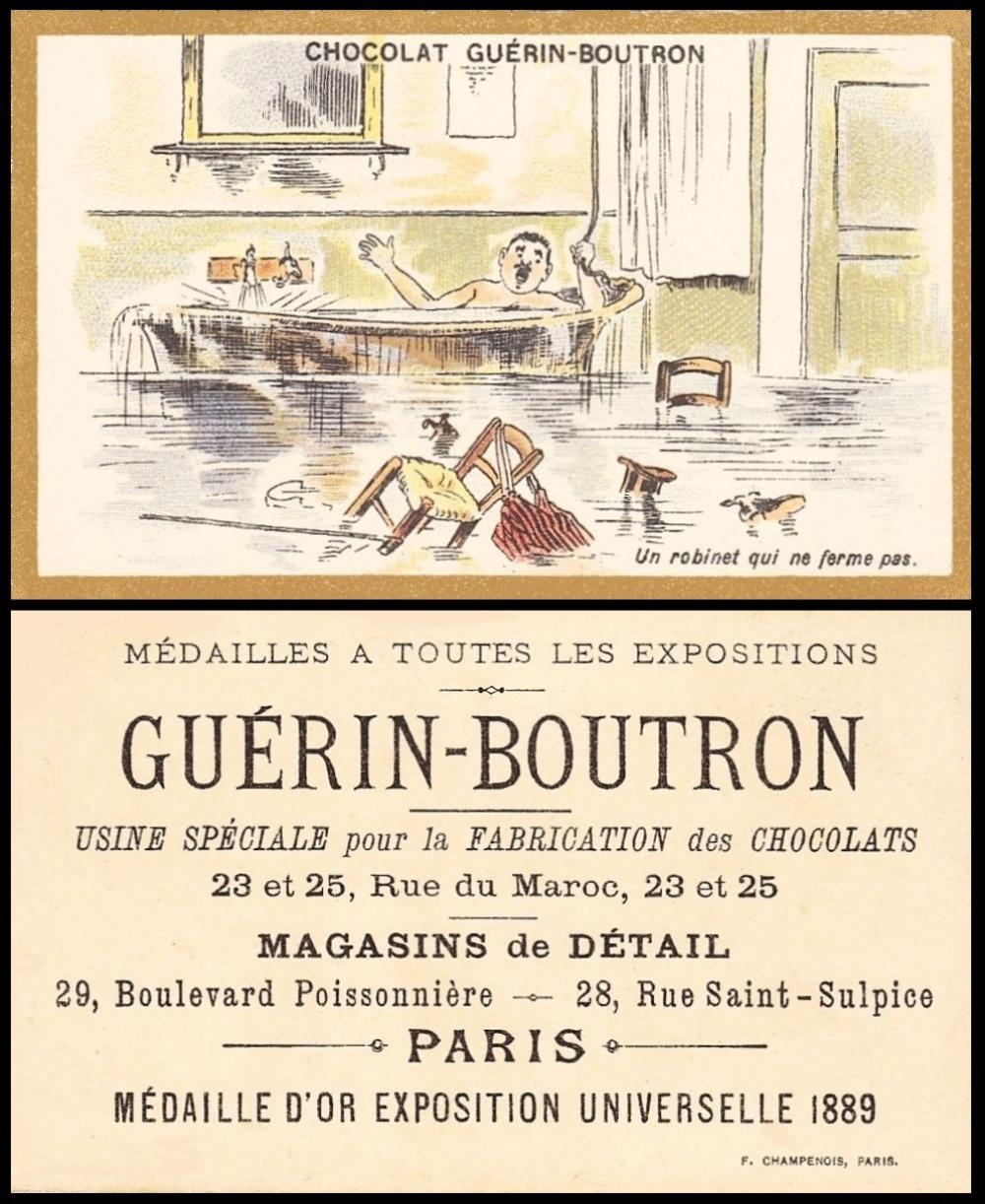
Guerin-Boutron [trade : chocolate : O/S - Paris, France] "Humorous Scenes"? (1900?) 1/?
When you run your bath, do you ever think to thank the tub, or take your time, with candles and rose petals? If not, why not do it today, on #NationalBathtubDay.
Now the story of the bath probably started when one caveman made personal remarks about another. Or perhaps a herdsman saw his flock go in a river with muddy feet, and notice they came out the other side unmudded. He probably then looked at his own feet and thought, why not.
Plumbing is universally agreed to have come along about 3000 B.C., or at least copper pipes have been discovered, in a European villa, dating to approximately that time. Europeans seem to have had proper baths, and lots of them, for many centuries before the British, which is why the Romans knew what to do when they discovered the mineral springs at Bath, etc. Britons did not bath very much at all, right until the eighteenth century.
Bathtubs on cards are quite hard to find, but here we have one, which is, unsurprisingly, from Europe. This humorous card of what happens when the tap will not turn off, was issued with chocolates. It is a very well equipped bathroom, with two chairs, seen floating about merrily, and a very ornate mirror on the wall. His clothing, striped undertrousers, shoes, and a top hat, are also riding the waves around the room. He is calling out, and this adds to the humour, as when someone comes to rescue him, and opens the door, they will release the water first, and the chairs... and oh what fun will ensue.
I really like cards like this, where you can imagine all kinds of scenarios to amuse yourself.
Some say that Europeans have no sense of humour. Well, this card proves that totally wrong.
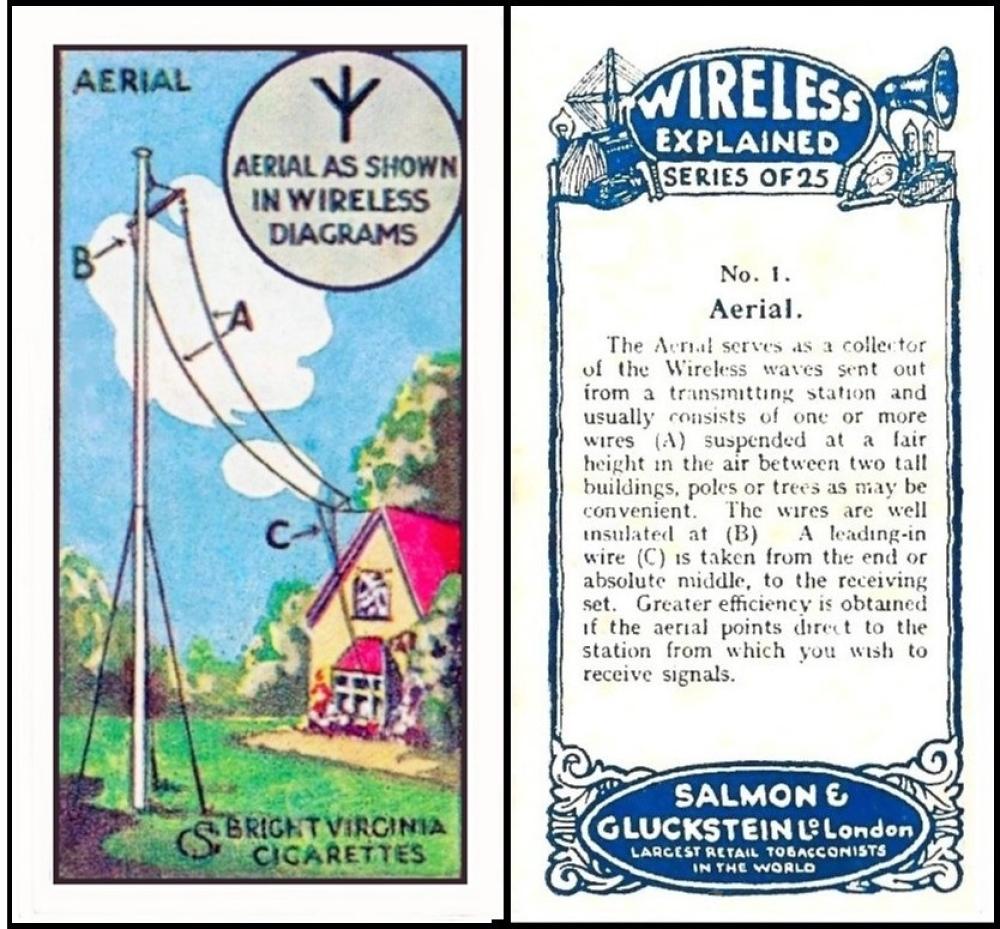
Salmon & Gluckstein [tobacco : UK] "Wireless Explained" (1923) 1/25 - S041-780 : S16-27
This is not the perfect card for today but we have not featured it before, and it is card number one, so very suitable for our tale.
It all starts in 1930, with a man who saw something happening, and instead of just joining in, decided to create something better.
The thing that used to happen was that when the young folk went out in their car, oft-times they took the big house radio with them, ostensibly to play at the picnic, but then someone turned it on as they drove along, and soon everyone was doing it.
Then a man called Paul V. Galvin wondered how he could make a purpose built radio for a car. After all, he was pretty sure there was a market. He already had an electrical company, the Galvin Manufacturing Corporation, with an HQ in Chicago, and they were in the radio business, but what they did was make a small but important part, called a battery eliminator. This did what it said, it eliminated the need for a battery and allowed radios to work on the household electricity supply instead. Unfortunately it was a simple thing to make, and also many companies were moving with the times, and producing their radios so that they were able to be unboxed and plugged straight in.
Our man decided to reverse the system, to have a radio that worked in a car, and one that was built in such a way that still allowed enough space, and ease of access, for passengers. This was no mean feat, and it was accomplished by fitting many of the parts underneath the car, including the banks of batteries.
Then he did something else amazing, he heard of a radio industry trade show, and drove there, though he had not booked a stand; he could not afford that. When he arrived in the area, he simply parked up and played the radio, using some old loudspeakers which he had extracted from a defunct model. Such a simple plan, but it worked, and soon he was getting lots of orders. But still one thing was missing, a catchy name.
He thought about it. He wanted to use "motor" in it somewhere, to show it fitted in a car. He went through hundreds of synonyms for music, and gramophone, until one day he saw a record player. This had been the first home-grown brand of record player in America, and he liked the connection. And so he called his car radio a "motor-victrola". I am not sure what happened then, it is possible that Victrola, rather than seeing it as extra advertising, took umbrage. Whatever, Mr. Galvin decided to change it, and what he did was to keep the first bit and shorten the second. This made "motorola".
And yes, this is the same company that now makes all manner of devices, mobile phones, tablets, software, radios, bar scanners, video cameras, and, still, car radios.
This set is rather scantily described in our World Tobacco Issues Indexes, only as :
WIRELESS EXPLAINED. Sm. 67 x 34. Nd. (25).
The cards say they were issued with Bright Virginia, though I have been unable to find this. All I have found was a yellow and red packet that says "A.R. Virginia", though it is certainly very bright. As are these cards!
They all describe a part of the wireless, starting with our Aerial and going through the Earth, Loose-Coupler, Variometer, Tuning Coil, Coil Holder, Variable Condenser, H.T. Battery, Fixed Condenser, Grid Condenser, Grid leak, Crystal Detector, Telephone Transformer, Valve, Filament Resistance, Fixed Aerial, Potentiometer, H.F. Transformer, I.F. Transformer, Accumulator, Loud Speaker, Buzzer, Morse Key, Telephone Receiver and Microphone. The fronts are very well labelled as to the parts.
I find them much more exciting than the brown monotone set by Godfrey Phillips of "How to Build a Two Valve Set" (1923), though it is very intriguing that the other two sets accompanying that one are suddenly in colour, and remarkably similar to this one by Salmon and Gluckstein - those being "How to Make Your Own Wireless Set" (also issued in 1923), and "How to make a Valve Amplifier" (issued in 1924)
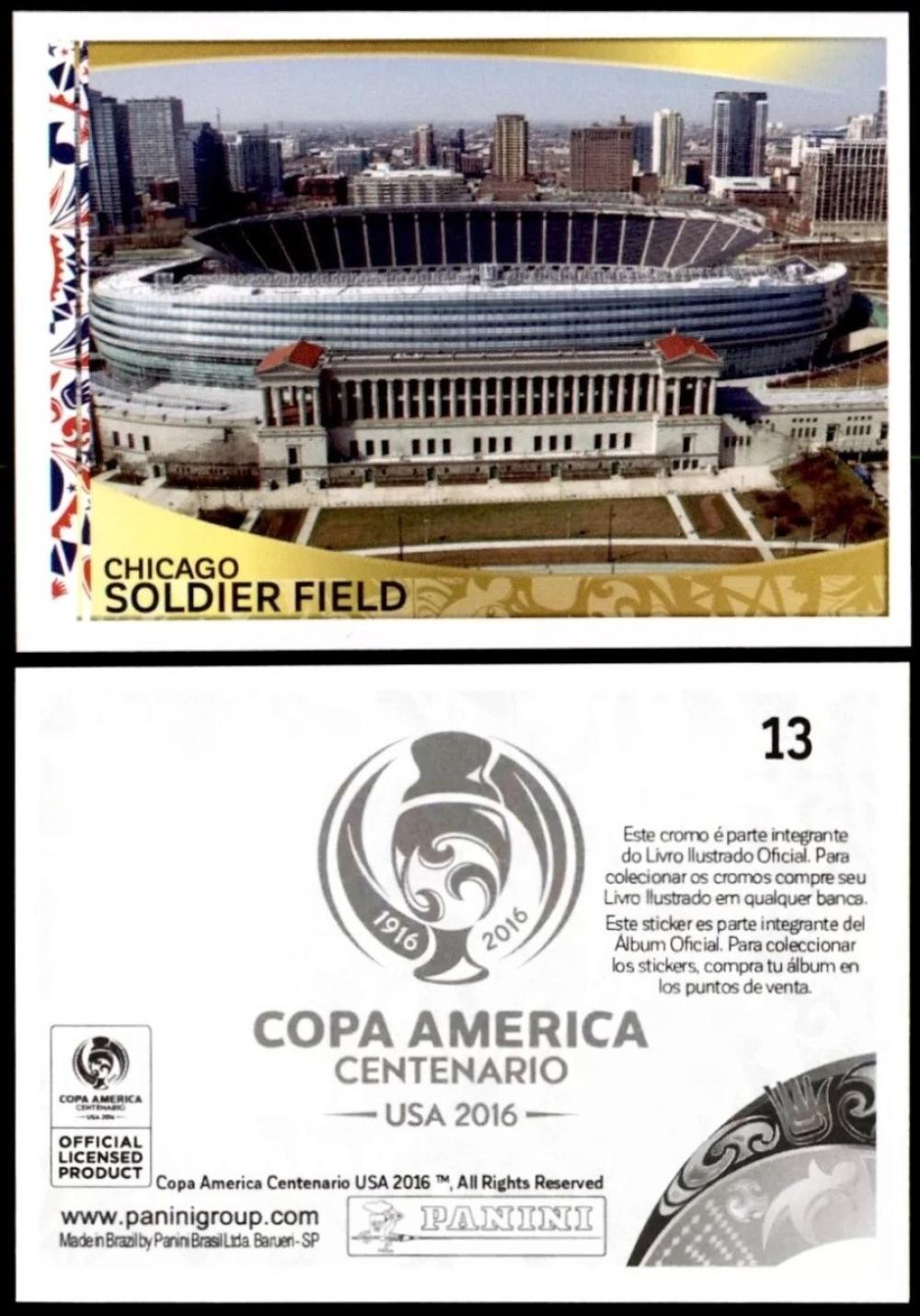
Panini [commercial : cards : O/S - Brazil] "Copa America Centenario" (2016) 13/452
We are staying in America now, and in Chicago - and today, in 1924, the newly opened Soldier Field Stadium re-enacted the Chicago Fire of 1871.
This stadium may be the smallest in the National Football League, but it not only serves the Chicago Bears, it also allows for soccer, with a team called, rather aptly, Chicago Fire.
The first event in the stadium was the Police Athletic Games on September 5, 1924. The next day, the stadium hosted music and fireworks, and a spectacular event which included a chariot race. All moneys went to the benevolent fund for the police and fire service - as it did until 1971. The first American football game there was played on October the 4th.
However, the big event came today, "Chicago Day" and included the formal dedication and opening of the Stadium. The star attraction was a re-enactment of the great fire, which had started when Mrs. O`Leary`s cow knocked over a lantern in a bed of straw. And, thrillingly, ten of the men who were there had actually fought the original fire in 1871. Plus a cow, but not the original one, of course.
This card is seldom seen on our shores, so I am grateful to the reader who supplied this scan.
The centenary part involved The South American Football Confederation, which was founded on the 9th of July, 1916, which was itself a centenary, of Argentina`s Independence (or more correctly the Independence of the United Provinces of South America).
The other bit - The Copa Americana - is a bit like the World Cup, and is also held every four years, but it is only contested between clubs from South America.
Now for some reason in 2016 this event was staged, for the first time, in North America. It was also different, with four extra teams taking part, including a "home team" of America. However it was treated as a separate event to the standard Copa Americana, which had taken place just a year earlier in 2015 and been won by Chile.
Perhaps because of its location, and the additional attraction of the American team, this separate event was one of the best attended ever, the crowds being swelled by local people who had never seen the teams or the sport before, or wanted to perhaps be able to say they were there in years to come.
Chile won the final, which ended in a goal-less draw after penalties; beating Argentina.
This set is very confusing, because there is another set, called "Adrenalyn XL Copa América Centenario USA", with two hundred and thirty four stickers. However those are mostly the players, and no stadiums appear.
Our set is even longer, and the key is that "Adrenalyn XL" bit which is missing from our stickers. It also features several stadiums at the front end of the set (after a few foil logo cards), these being The Rose Bowl, Met Life, NRG, Lincoln Financial, Gillette, Levi`s, Century Link, The Citrus Bowl, The University of Phoenix and our card of Soldier Field.
You got thirty five stickers in every packet for $1.99.
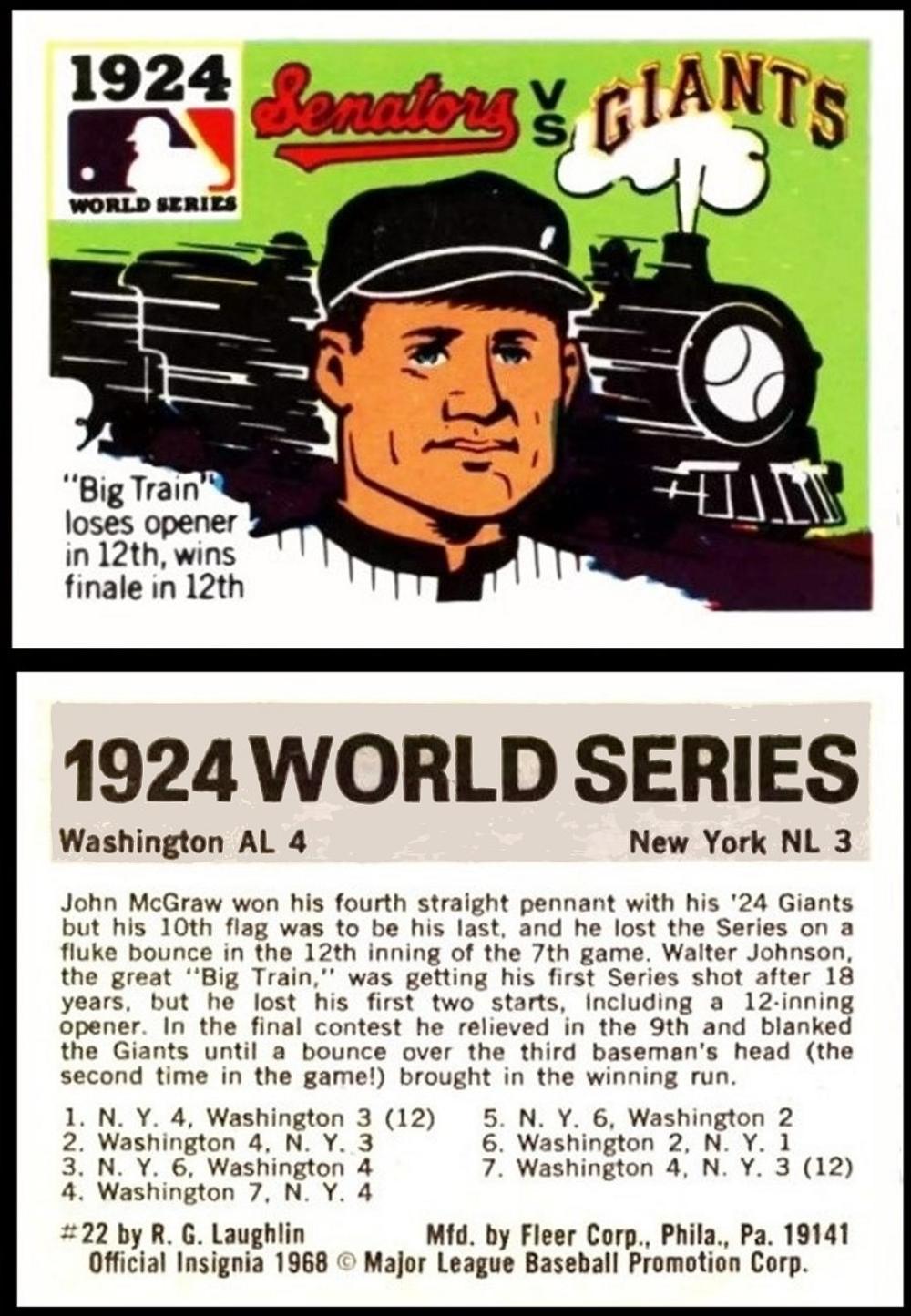
Fleer/Laughlin [trade : O/S - USA] "World Series Baseball Trading Cards" (1968) Un/
This seems to a rather Americanised newsletter, but this is also a centenary, for today in 1924 the Washington Senators beat the New York Giants to win the World Series. They did this by taking four of the seven games, and with style, for this particular game is still the longest ever played, twelve innings long.
Man of the Match was Walter Perry Johnson, playing for the Washington Senators. He had been born in 1887, in Kansas, and was a major force in the sport, over six feet tall and nicknamed `The Big Train`. Many players, including top ones, held him in awe, though he never went to college, and started his career in the sport aged 19 in 1907, reportedly being signed for a hundred dollars, which was quite a tidy sum back then.
The Washington Senators were one of the first baseball teams to be founded, in 1901. They changed their name to the Washington Nationals in 1905, and so they remained until the mid 1950s, when they reverted to their original name again. And then, in the 1960s, they changed their name and their location, and became the Minnesota Twins.
This is an unusual set, and I am not so fond of it, the cartoons seem a little garish for my liking, but it fits this theme amazingly well and I know of nobody with a card of Walter Johnson though there are over a thousand of them listed on the Trading Card Database. They list his "Rookie Card" as being issued by the "Police Gazette" in 1901, but his appearance was not until 1913. In any event these are large supplements not cards, removed from the actual paper. Then there are a lot of postcards.
Most cartophilists therefore regard his first appearance as the card which appears in the untitled set of "Baseball Players" issued in 1909 by the Boston company of Mentor with their "Ramly" brand of cigarettes - catalogued as T.204, and containing a hundred and twenty-one square format cards. If you work down the list at the Trading Card Database by some way you will find it. However, in our original World Tobacco Issues Index it is listed under American Tobacco Group Issues, not Mentor, as :
BASEBALL SERIES - BURDICK T.204 (A). Md. 63 x 51. Black and white oval or square centres, gold and white background. Unnd. (120 known). Brand issues, inscribed (a) "Ramly" (b) "TTT Natural Turkish". See ABC/T.204. Ref. USA/204. For Anonymous issue see Set ZJ3-17. ... A54-15
That Anonymous "Z" card also links back to American Tobacco.
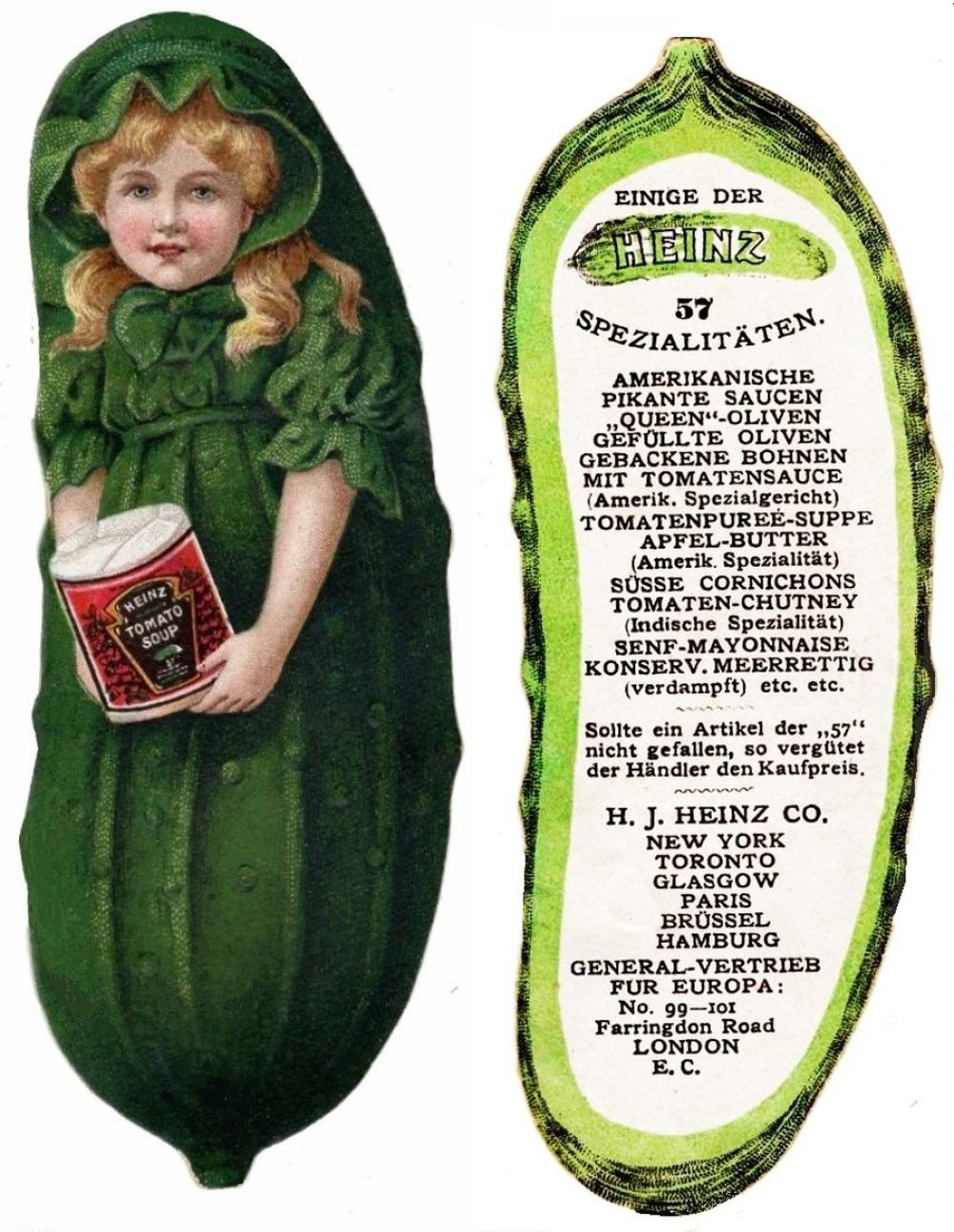
H. J. Heinz [trade : food : O/S - Europe] "Pickle Advert" - German (1898)
And so, to close, have a pickle. This marks the fact that today is the hundred and fifty-fifth birthday of the founding of H. J Heinz and Company. And it is also very satisfying to at last find a scan of the much rarer European versions of these little die cut cards.
It seems an odd thing to squeeze a child inside a pickle so that just their head protrudes, but these cards were amazingly popular and there are loads of them, all different - children, some in chef`s attire and some cute with ringlets - plus beautiful young ladies - and even really scarce ones which are horizontal format and have a child`s head at each end of the pickle. In addition some of them have wording on the front, rising up the pickle, "Heinz Sweet Pickle" being the most common.
They all had advert backs, so if you see one with a plain back it has almost certainly been removed from being stuck to an album page. Be careful, and do ask to see it out of the plastic sleeve in which it is hiding, even if it has a see through back.
We know that the first ones of these advertising cards were produced in 1893, for the World's Columbian Exposition in Chicago. This was also the debut of the little plastic three dimensional pickle charm, just over an inch long, though the first ones were made instead of gutta percha, a kind of latex. You can tell the difference because the wording is much fuzzier on these than the later plastic ones. Also the very first ones of all were made to go on a watch chain. The ones with the pins came later.
According to a collector friend, there are twenty-five different designs, but these have several variations, including colours of clothing. They are as thick as a standard cigarette card. The main green body of the pickle is embossed too, so that it feels like an actual pickle (if you are very imaginative). There is another variation too, because sometimes the backs are entirely white and other times they have a green margin around the wording.
Then there is an American one on which the text gives the times of opening for the Pittsburgh Office - this is thought to have been issued at an exhibition in Pittsburgh, with the idea being that during the exhibition they would allow for visitors to the factory as well. This is backed up by the fact that these ones are very hard to find so they must have been issued in less numbers than the rest, and also why would anyone in another state or country care when the plant and offices were open?
The London office was opened in 1896, and, according to this card, they handled the European sales too. This German example is much more sought after than the American ones, but you can also find them in other languages, French being the most easy to find.
Anyway, as usually happens, these little cards were very popular and collectable, and then in 1904 it was decided to discontinue them. Nobody knows why. They did last for a little longer, and you can find some which say, at the very bottom "Grand Prix, Exposition de Liege, 1905".
This week's Cards of the Day...
... saw us nipping along to the Cheltenham Literary Festival, which is also celebrating its Diamond Jubilee - seventy-five years old this year.
It begins on the fourth of October and continues to the thirteenth, and you can read lots more at their website, which is : https://www.cheltenhamfestivals.org/
The festival was founded by the manager of Cheltenham Spa, George Wilkinson, with a lot of help and input from a local author called John Moore, who agreed to become the first ever director. It was designed purely to celebrate and encourage a love of reading, both in your head and verbally delivered. So it contained prose and verse, and hoped to attract both known and unknown authors to attend.
Today it has events for all ages, and especially hopes to foster a love of reading in the hearts of those for whom what some find a simple act is more of a struggle, either through disability, or circumstance. There are also many events for school children.
Saturday, 28th September 2024
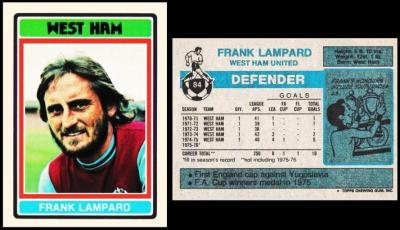
Here we have Frank Richard George Lampard, who was born in September 1948. He is shown in his West Ham colours, which he wore for most of his life, starting in 1967, though he did also play for Southend United, and for England.
We were a bit sneaky with our clue here as we were after his son, who was born not too long after these cards were issued (in 1978), and even then, not because of his club, nor his birthplace, but as an author, of children`s books, including the "Frankie`s Magic Football" series, of which there are almost twenty, and each of which come with collectable cards.
This set may look similar to those issued by A & B.C. Gum, and you would be forgiven for thinking that there must have been some kind of error, like them forgetting to change the Topps name before they were printed. However in the mid 1970s things changed, and Topps took the license back, so the last set issued by A. & B.C. was "Footballers 1974-75". After that the sets were issued by Topps UK, with Bazooka bubble gum, so they are very much still proper trade - though, intriguingly, their name is given on the back as "Topps Chewing Gum, Inc." This is even odder, when you consider that their earlier set, known as "Footballers - Red/grey back" has "Topps Bazooka Limited" in that place, and that both these sets show a pack of Bazooka gum on their wax packets.
If you look at the packets for this set you will see that it is billed as the "Biggest Series Ever" and there were three hundred and thirty cards, all individual footballers from either the First or Second Division. That was a hundred and ten more cards than the set before, and it was not beaten until the 1978 set with the orange backs, which had three hundred and ninety six cards.
It is catalogued in our original British Trade Index, part III, as :
FOOTBALLERS 1976 (A). 89 x 63. Back "Topps Chewing Gum Inc.", latest dating on backs is "Season 1975-76".
1. English edition. Back in blue. Nd. (330)
2. Scottish edition. Back in red. Nd. (132)
Sunday, 29th September 2024
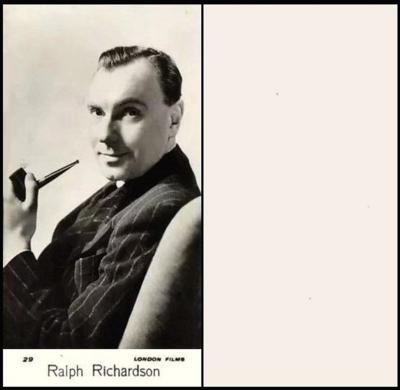
This clue was another sneaky one, but it refers to the fact that this man, the actor, Ralph Richardson, was not only born in Cheltenham but delivered the launching speech at the very first literature festival there in 1949.
Now we know that Ralph Richardson did smoke a pipe in real life, therefore this is probably not a scene from a movie. His first film was "The Ghoul" and his second "Friday the Thirteenth" - both of those were released in 1933. At the time this picture was taken he was working steadily, and in 1939 he appeared in five movies ("Q Planes", "The Four Feathers", "Smith", "The Night of the Fire", "The Lion Has Wings").
In the last of these films he played Wing Commander Richardson. This leads rather nicely to a pair of often misquoted facts. Firstly, whilst it is often reported that at the outbreak of the Second World War he had joined the Royal Navy Volunteer Reserve, he was in fact a pilot for them, and he had also flown before the war, just for fun. And secondly, before any comparison between his real rank (of Lieutenant Commander) and his film rank (of Wing Commander) it must be noted that the rank of Lieutenant Commander in the Royal Navy is actually equivalent to that of Wing Commander in the Royal Air Force.
This set first appears as an anonymous issue in our original British Trade Index, which became known later as part I. It comes as part of a very extensive "Film Star Grouping" of which our section (ZJ4-15) covers Bridgewater and De Beukaelaer issues as well as anonymous cards in a similar style whose issuer was not yet known.
Since we appear not to have featured Bridgewater cards as a Card of the Day before, this will be the home page for their Film Star cards, and will host the entire listing, which reads :
SET ZJ4-15. FILM AND RADIO STARS - BRIDGEWATER/BEUKELAER STYLE (A). See D.102. Many special albums issued. ... ZJ4-15
1. Bridgewater issues. All photos. Min 48-49 x 28 except (9) [which is larger].
1. 1932 Film Stars, 1st Series. Black. Nd. CE1/96. See D102-5.1
2. 1933 Film Stars, 2nd Series. Black. Nd. E1/96. See D102-5.2
3. 1934 Film Stars, 3rd Series. Black. Nd. 1/96. See D102-5.11
4. 1935 Film Stars, 4th Series. Brown, coloured.. Nd. (48) See D102-2.1
5. 1935 Radio Stars, 1st Series. Black. Nd. (48) See D102-5.12
6. 1936 Radio Stars, 2nd Series. Brown, coloured. Nd. (48). See D102-3.1
7. 1937 Film Stars, 5th Series. Brown, (a) coloured (b) uncoloured. Nd. (48). See D102-2.2
8. 1938 Film Stars, 6th Series. Brown, coloured. Nd. F1/48. See D102-1.2
9. 1939 Film Stars, 7th Series. Sm. 67 x 35. Nd. (48). Black. See D102-1.1
10. 1940 Film Stars, 8th Series. Black. Nd. (48). See D102-3.11
Because it might be a bit wordy to add them all in here, those D references will only be added on the link pages to each set, as they appear. Therefore the one for our set, which comes under Group one of the D102 listing of the "Anonymous Miniature Card Grouping", reads :
GROUP 1 - Photos Without Borders - Number, Caption, and Name of Film Company in Base Panel (as card illustrated)
1.1 - Small, 67 x 35 m/m. Black, glossy. Numbered 1/48. "Film Stars". Issued by Bridgewater, 1939. Card illustrated at Fig. D102 is No.27 in this Set ZJ4-15.1 (9) - Bonita Granville.
There then follows a list of all the cards in the set, which will be scanned.
By the time of our updated British Trade Index the sets have been retrieved from the back of the book and been listed under Bridgwater. That listing reads :
BRIDGEWATER.
Biscuits. Issued 1930s, except the advert card [of Queen Victoria, issued much earlier]. Believed albums issued with all Film Star and Radio Stars sets.
FILM STARS (A) 1932. 48 x 28. 1st Series. White borders. Black photos. Nd. CE1/CE96. Two different subjects at No.45, but no No.47. No.54 has no "CE". Plain back. Anonymous. Also issued with and without numbers - some hand coloured, in Europe, with "CE" on No.54, and with printed backs by Lorrain and Moreuil. ... BRI-040.
FILM STARS (A) 1933. 48 x 28. 2nd Series. White borders. Black photos. Nd. E1/E96. Plain back. Anonymous. Also issued with printed backs, as above ... BRI-050.FILM STARS (A) 1934. 48 x 28. 3rd Series. White borders. Black photos. Nd. 1/96. Studio name BELOW caption. Plain back. Anonymous. ... BRI-060.
FILM STARS (A) 1935. 48 x 28. 4th Series.Brown coloured. Nd. 1/48. Listed at HB-163 as this set and BRI-080 are identical format. Plain back. Anonymous. ... BRI-070.
[the Radio Stars are not listed in this volume until after the final film star set]
FILM STARS (A) 1937. 48 x 28. 5th Series. Brown, (a) coloured (b) uncoloured. Nd.1/48. As above, listed at HB-163, for identification Plain back. Anonymous. ... BRI-080
FILM STARS (A) 1938. 48 x 28. 6th Series. Brown, glossy, hand coloured. Nd. F1/48. Album issued inscribed "6th Series". Plain back. Anonymous. ... BRI-090.
FILM STARS (A) 1939. 67 x 35. 7th Series. No borders. Black glossy photos. Nd. (48). No., caption and Studio name in base panel. Plain back. Anonymous. ... BRI-100.
FILM STARS (A) 1940. 48 x 28. 8th Series. Black photos. Nd. (48). No. and Studio name at front base. See HB-164. Plain back. Anonymous. Listed to assist identification ... BRI-110
Monday, 30th September 2024
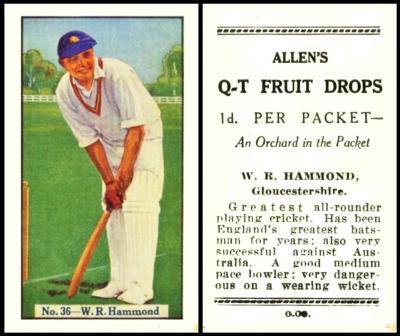
This card was chosen because of the county for which W.R. Hammond played, and that was Gloucestershire - for that is also the county in which resides our festival town of Cheltenham.
Gloucestershire County Cricket Club was founded in 1870, to all intents and purposes by none other than W.G. Grace, who also captained their very first match, on June 2nd 1870, against Surrey, at Durdham Down in Bristol. His brother was also the Club Secretary.
Gloucestershire did not have a permanent ground of their own until July 1889, when one was opened at Nevil Road, also in Bristol, and christened with a match against Lancashire. Despite this they were still the best County Team in England three times outright ( 1874, 1876, and 1877) and shared it in 1873, with Nottinghamshire. It ought to be noted at this point that the idea of a County Championship was something else that W.G. Grace encouraged, if not suggested.
This tale begins with one man, Alfred Weaver Allen, who started making sweets as a sideline in a little shed behind his shop in Fitzroy in 1891.
He knew all about sweets because he was also working for MacRobertson`s, the local confectionery factory, and had previously worked at Dillon, Burrows and Co. who were the pioneers of Australian confectionery, though neither man was Australian, Mr. Dillon coming from Cornwall, and Mr. Burrows hailing from Jersey. Strangely Mr. MacRobertson, (which is a slighly incorrect name as he was called Macpherson Robertson), was not Australian either, he was born in Scotland.
In 1917 our man started amalgamating with other confectioners, and later on, in 1922, he opened his own company, A. W. Allen Ltd, though he did not build his own factory until 1924. Sadly he died the following year, in October 1925, aged just fifty five, and so never got to see many of what would become his best selling brands, including our Q.T. Fruit Drops, which was introduced in 1927.
As for our cricketer, Walter Reginald Hammond, he was born in Dover on the 19th of June, 1903, and he outlived this card by almost thirty years. His forte was as a batsman, one of England`s best, so much so that he captained England. As a child he travelled widely, due to his father`s military service - but this ended with the outbreak of the First World War, in which his father was killed. His widow moved down to the South Coast and sent young Walter to a local school but then it was agreed that he should go to a boarding school, and Cirencester was chosen. There he settled in well, and much enjoyed sports of all kinds - in fact it was his prowess on the cricket pitch there which led to him being taken on by Gloucestershire County Cricket Club.
This is one of several sets of cricketers issued by Allen, starting in 1924. They all appear in our original Australian & New Zealand Index, issued in 1983 as reference book RB.30. It is a scarce volume, so I was lucky to not only find one at all, but one being sold at a very reasonable rate, for it is long out of print.
Our set appears in that volume as :
Cricketers - 1938 (A). 67 x 39. Front and back per Fig, AL2-11. Action pictures or head and shoulder studies. Back in black, dotted lines top and base, no vertical lines. Multi backed, four advertisements, 36 different known. Nd. (36). "Boys Captain" issued Nos. 1/18, see Set. BO6-1 ... AL2-11
This is followed by a list, which will eventually be scanned in but does not identify the adverts, only by codes, which are somewhat baffling as to why they are the codes. But never mind, we will add a list below, which will give the code plus the advert text. The illustration they show, which will also appear at the same time as that list is our card, of W.R. Hammond, but in black and white, and with a different advertisement back, for Irish Moss Gum Jubes. However there was only one advertisement used on each card and so it ought to have been "Q-T" - the simplest way to explain this is that the supplier of this illustration most probably had two cards from the set and used a front of one with a back of another simply because it was the only possible way to take a picture of both the front and the back at the same time.
The full list of advertisements are :
- ( C ) - Allens Cure-Em-Quick. Stops Coughing Instantly. Sold in 3d Packets and 3d. Tubes.
- ( IS ) - At the first sign of a cold take - Allen`s Irish Moss Gum Jubes. You can feel them doing you good. Sold in 3d and 6d packets.
- ( IQ ) - Allen`s Q-T Fruit Drops. 1d a Packet - An Orchard in the Packet
- ( QS) - Allen`s Steam Rollers. 1d a packet. The Perfect Peppermint.
Tuesday, 1st October 2024
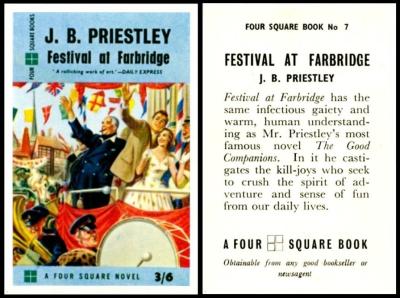
The story of this book, by John Boynton Priestley, is how a group of differing people come together, and manage to convince a little town, far away from anywhere, to have a festival. In doing so they find how much they have in common with each other, as villagers and as people of Britain. Its a very pleasant tale though some today may deem it old fashioned.
I cannot help comparing their efforts with the story of the Cheltenham Literature Festival, because although the premise of the story was that the town was to join in with the Festival of Britain, in London, that did not actually open until May 3rd, 1951, and our book was published months earlier, on January 1st 1951.
As far as I know, J.B. Priestley never attended Cheltenham, but he was very supportive of such events and there is much to connect him with Ilkley Literature Festival, in his home county of Yorkshire, which began in 1973 - and the idea of which was directly based on trips, by the founder, to the festival at Cheltenham.
J.B. Priestley appears on just two other cigarette cards, in Stephen Mitchell`s "A Gallery of 1934" (issued in 1935) and in W.D. & H.O. Wills` "Famous British Authors" (1937).
Now this is probably a big surprise to some readers, but these cards were indeed issued with tobacco. Also, though they were issued through George Dobie & Son, by this time that company was part of Godfrey Phillips. And, intriguingly, the books were published by Landsborough Publications, another subsidiary of Godfrey Phillips.
Now if you look in our original World Tobacco Issues Index, though George Dobie is listed, you will not find these cards, for they were issued three years after that book had been published. But you will find two sets of earlier cards, which are discussed with our Card of the Day for the 24th of January 2025.
In the updated World Tobacco Issues Index, though, you will find the earlier cards, and these, listed under section 2. "Issues in 1959-60", where they are described as :
Inscribed "Four Square Books" without reference to tobacco. These cards were issued after Dobie became part of the Godfrey Phillips Group.
FOUR SQUARE BOOKS. Md. 75 x 50. Nd. (96) Issued in three batches of 32. ... D600-530
We know that the three series were numbered 1-32 (issued in 1959), 33-64 (also issued in 1959), and 65-96 (issued in 1960). The fronts are actual replicas of the book shown, and also show the cover price, whilst on the back is a short synopsis of the plot, without giving too much away. One of the most sought after is from the third series, it is "Tarzan of the Apes" by Edgar Rice Burroughs, first published in 1914, and re-published by Four Square Books in 1959 for 2/6d. Now the book was number 87 and so is the card, so it seems likely that the rest of the books are also the same numbers as those cards from this series. I will check that out, later.
Wednesday, 2nd October 2024
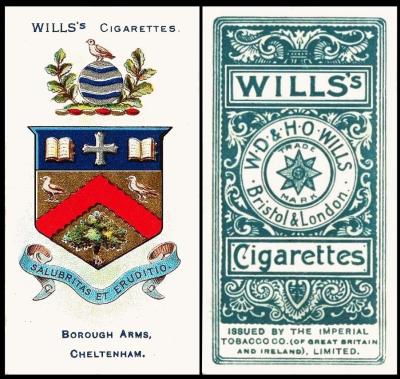
So at last we have a card of Group one of this set ! And you can read about all the rest of this fascinating group in our research blogs, under "B for Borough Arms".
This card is included not just for that reason though, for look, it shows open books, and with proper bindings. The correct description of the arms is "A chevron engrailed gules between two pigeons in chief and an uprooted oak tree in base proper. A silver cross flory on an azure chief between two open books, also proper binding and clasps of the first." There is a story to this, and it revolves round those pigeons, for the spring which brought fame to the borough was only discovered by it being repeatedly visited by flocks of birds, and when tasted it was discovered not to just be water, but to be salty, and therefore different, worthy of investigation. The trees are there because Cheltenham is also famed for its many trees.
This coat-of-arms was only granted in 1877, and the books were included simply to show that it was a centre of education, in fact the banner inscription is Latin, "Salubritas et Eruditio" - which translates to "health and learning". The oldest reference on the entire arms is that little silver cross, on the top line of the shield, for that stands for Edward the Confessor, the owner of much of the land that today lies beneath Cheltenham.
This set is a long one, with many sections, but today`s card comes from the group which was issued first of all. That was described in our Wills reference booklet part II (RB.11, issued in 1948) as :
19. BOROUGH ARMS (untitled).
This series comprises City, University, Town and Borough Arms; it is perhaps best known under the title "Borough Arms" although "Civic and University Arms" might be a more accurate description.
Fronts printed in full colour, no frame lines, with "Wills` Cigarettes" across fronts of cards. Numbered series have numbers on fronts in small circle, or on backs with text. Backs in grey, with modified star and circle ornamental design to permit insertion of Imperial Tobacco Clause at base. No "Ld." after Wills` name in circle. Later series have text and maker`s name on backs. Issue date from June, 1904
Printed by Mardon, Son & Hall.1. Unnumbered set of 50 (as detailed overleaf) with modified Star and Circle ornamental design backs, with I.T.C. Clause. Backs in blue-grey.
This comparison table, which follows in that original booklet, lists the cards in this first set in alphabetical order, but adds two columns that show the different numbering between the second and third printings, both of which were numbered, differently.
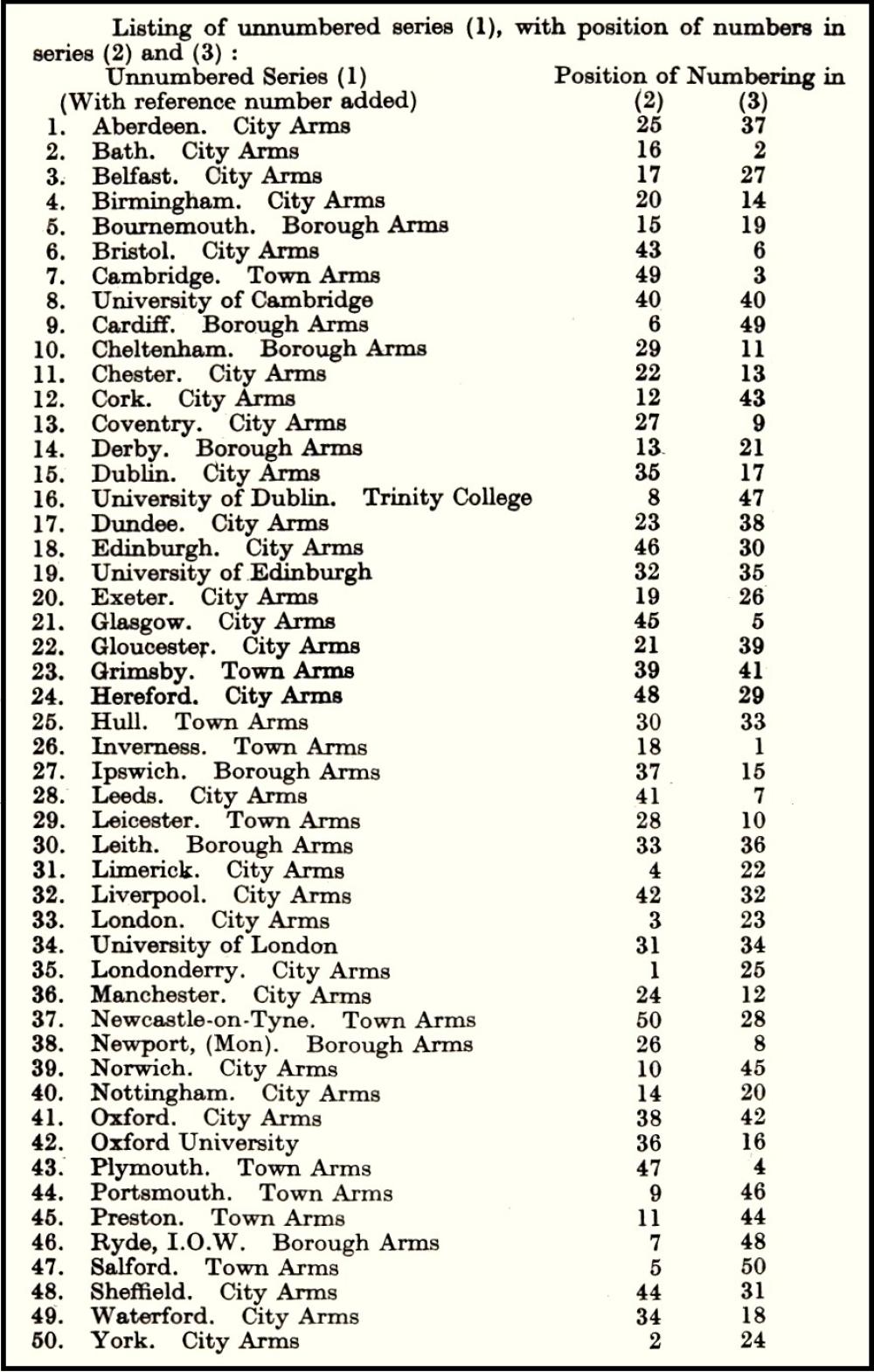
In our original World Tobacco Issues Index, tthis list is missing, but our part of the set is described as simply :
BOROUGH ARMS. (A). Sm. See W/19. ... W62-62
1. First 50 subjects
A. Scroll back. Front (a) unnumbered (b) numbered
B. Descriptive back with (a) plain numeral (b) numeral and "Second Edition".
This is exactly the same text in our updated World Tobacco Issues Index, but a new code has been generated.
Thursday, 3rd October 2024
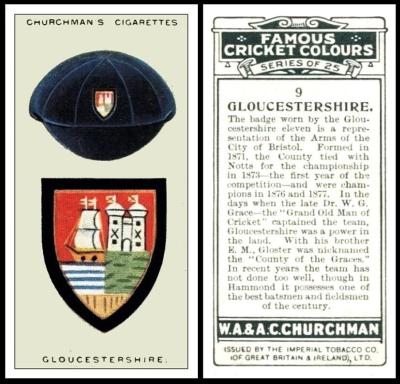
Here we have the badge and cap of Gloucestershire County Cricket Club, and this was sent in by a reader because it mentions some of the facts we spoke of with our Card of the Day on Monday the 30th of September - namely their being founded in 1871, tying with Nottinghamshire for the Championship in 1873, and being champions outright in 1876 and 1877. It also mentions Hammond, the man on that card, and describes him as “one of the best batsmen and fielders of the Century”.
The set is quite fascinating for cricket collectors. It starts with the Marylebone Cricket Club, and their very unusual red and yellow hooped cap. Their touring cap is quite different, and that is card number three. In between is the cap of England, the one which all players hope to one day wear with pride. I think these cards are in the wrong order, because cards four and five are Australia and South Africa, which would have better followed England.
Cards six to twenty-two are the County teams - which are, in numerical order, Derbyshire, Essex, Glamorgan, Gloucestershire, Hampshire, Kent, Lancashire, Leicestershire, Middlesex, Northamptonshire, Nottinghamshire, Somerset, Sussex, Surrey (these two being slightly out of order), Warwickshire, Worcestershire and Yorkshire.
Then come the two teams of Cambridge and Oxford Universities.
Last of all comes I Zingari, which is described on the reverse as follows : "One of the greatest honours that cricket can offer is to be made a member of the brotherhood of I Zingari. I Zingari was formed in 1845 by a number of Cambridge sportsmen, who, in their leisure hours, indulged in cricket and theatricals. There is no entrance fee or annual subscription. The famous black, red and gold - "Out of darkness, through fire, into light" has ever stood for all that is good in Cricket, while the three Zingaric principles are famous - "Keep your promise, Keep your temper, Keep your wicket up."
In our original Churchman booklet (RB.10, issued in 1948) the entry for this set reads :
50. MAY 1928. 25 FAMOUS CRICKET COLOURS (titled series). Size 2-11/16 x 1-7/16 or 67 x 36 m/m. Numbered 1-25. Fronts printed by letterpress, 4-colour half tone process. Backs in dark green, with descriptions. Printed by Mardon, Son and Hall.
This is much reduced in our original World \Tobacco Issues Index, to
FAMOUS CRICKET COLOURS. Sm. Nd. (25) ... C82-46
This text remains the same in our updated volume but the code has changed.
Now hold on to your hats, because I have been sent a scan of something quite amazing for tomorrow.
Friday, 4th October 2024
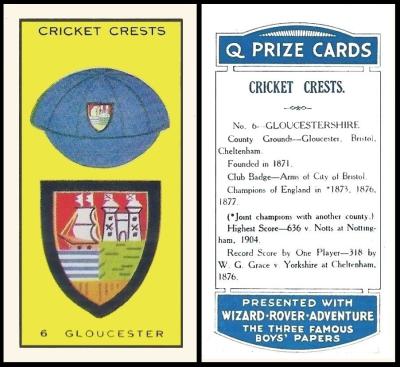
Pretty neat, eh !
This front is identical in style to yesterday`s card, but the colour of the background and the cap is different, and where it said "Churchman`s Cigarettes" it now says "Cricket Crests". The back, though, is different, and there are also only sixteen cards in this set, not twenty-five.
Now "Cricket Crests" is not the title of the set, just this section of it. The whole group is catalogued in our original British Trade Index part I as :
Q PRIZE CARDS. Sm. 67 x 37. (A), (R), (W). Three sub series. Nd. ... THO-25
1. Cricket Crests. (16)
2. Flags of All Nations (16)
3. Queer Birds (16.
By the way, before I race on, those initials in the brackets are for "Adventure", "Rover" and "Wizard" magazines, in which these cards were issued.
There is a tantalising idea here, and that is whether the other sections of this set were also based on cigarette cards. If so, it may well be the case that their owners, who specialise in trade cards only, have not got the slightest idea, for the supplier of this scan tells me it came as a great shock to him to find his Thomson cards had a long lost brother in the Churchman set of yesterday.
By the time of our updated British Trade Index, the parts of this set, oddly, have been parted. Our set now appears as :
CRICKET CRESTS (AD), (R), (W). 1934. 67 x 37. Nd.(17). Note 16 cards, last card being numbered 16 and 17. Q Prize Cards. ... THO-130
The other parts read "FLAGS OF ALL NATIONS (AD), (R), (W). 1934. 67 x 37. Nd.(16). Q Prize Cards. ... THO-245" and "QUEER BIRDS (AD), (R), (W). 1934. 67 x 37. Nd.(16). Q Prize Cards. ... THO-545"
And that`s my cue to turn in for the night. My canine companion has been asleep for ages, and he is always still snoozing when I wake, though he opens an eye as soon as I reach for a croissant, so that he may share.
If you are off to a fair this weekend, best of luck, and happy hunting. They will start popping up a lot now that the year is coming towards an end, so if you find one in your area do go along. On a cold crisp day maybe make a journey of it and go to one by train that is a little further away.
And, Branch Secretaries, please do let us have a list of next year`s events as soon as you can. Your audience is waiting, and ready to attend.....
